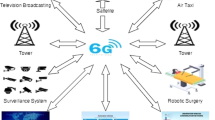Abstract
In global mobility networks, anonymous user authentication is an essential task for enabling roaming service. In a recent paper, Jiang et al. proposed a smart card based anonymous user authentication scheme for roaming service in global mobility networks. This scheme can protect user privacy and is believed to have many abilities to resist a range of network attacks, even if the secret information stored in the smart card is compromised. In this paper, we analyze the security of Jiang et al.’s scheme, and show that the scheme is in fact insecure against the stolen-verifier attack and replay attack. Then, we also propose a new smart card based anonymous user authentication scheme for roaming service. Compared with the existing schemes, our protocol uses a different user authentication mechanism, which does not require the home agent to share a static secret key with the foreign agent, and hence, it is more practical and realistic. We show that our proposed scheme can provide stronger security than previous protocols.

Similar content being viewed by others
References
Chang, C., Lee, J., & Chang, Y. (2005). Efficient authentication protocols of GSM. Computer Communications, 28(8), 921–928.
Chang, C., Lee, C., & Chiu, Y. (2009). Enhanced authentication scheme with anonymity for roaming service in global mobility networks. Computer Communications, 32(4), 611–618.
Chaum, D. (1985). Security without identification: Trunsactions systems to make big brother obsolete. Communications of the ACM, 28(10), 1030–1044.
Das, A. (2013). A secure and effective user authentication and privacy preserving protocol with smart cards for wireless communications. Networking Science, 2(1–2), 12–27.
ETSI TS 102 165–1 V4.1.1 Telecommunications and internet protocol harmonization over networks (TIPHON) release 4; protocol framework definition; methods and protocols for security; part 1: Threat analysis.
Fatemi, M., Salimi, S., & Salahi, A. (2010). Anonymous roaming in universal mobile telecommunication system mobile networks. IET Information Security, 4(2), 93–103.
He, D., Ma, M., Zhang, Y., & Chen, C. (2010). A strong user authentication scheme with smart cards for wireless communications. Computer Communications, 34(3), 367–374.
He, D., Chan, S., Chen, C., & Bu, J. (2011). Design and validation of an efficient authentication scheme with anonymity for roaming service in global mobility networks. Wireless Personal Communications, 61, 465–476.
IEEE 1363–2000: IEEE Standard Specifications For Public Key Cryptography. Institute of Electrical and Electronics Engineers, 2000.
Jiang, Q., Ma, J., Li, G., & Yang, L. (2013). An enhanced authentication scheme with privacy preservation for roaming service in global mobility networks. Wireless Personal Communications, 68, 1477–1491.
Lee, C., Hwang, M., & Liao, I. (2008). A new authentication protocol based on pointer forwarding for mobile communications. Wireless Communication and Mobile Computing, 8(5), 661–672.
Lee, C., Hwang, M., & Yang, W. (2003). Extension of authentication protocol for GSM. IEE Proceedings Communications, 150(2), 91–95.
Lee, C., Hwang, M., & Liao, I. (2006). Security enhancement on a new authentication scheme with anonymity for wireless environments. IEEE Transactions on Industrial Electronics, 53(5), 1683–1686.
Lee, T., Chang, C., & Hwang, T. (2005). Private authentication techniques for the global mobility network. Wireless Personal Communications, 35(4), 329–336.
Lee, J., Chang, J., & Lee, D. (2009). Security flaw of authentication scheme with anonymity for wireless communications. IEEE Communications Letters, 13(5), 292–293.
Menezes, A., Van Oorschot, P., & Vanstone, S. (1997). Handbook of applied cryptography. Boca Raton, FL: CRC.
Rosen, K. (1988). Elementary number theory and its applications. Reading, MA: Addison-Wesley.
Syverson, P. (1994), A taxonomy of replay attacks. In Proceedings IEEE computer security foundations workshop VII, pp. 131–136.
Wang, R., Juang, W., & Lei, C. (2009). A robust authentication scheme with user anonymity for wireless environments. International Journal of Innovative Computing, Information and Control, 5(4), 1069–1080. http://grouper.ieee.org/groups/1363/.
Wang, R., Juang, W., & Lei, C. (2011). Robust authentication and key agreement scheme preserving the privacy of secret key. Computer Communications, 34(3), 274–280.
Wu, C., Lee, B., & Tsaur, W. (2008). A secure authentication scheme with anonymity for wireless communications. IEEE Communications Letters, 12(10), 722–723.
Yang, G., Wong, D., Wang, H., & Deng, X. (2008). Two-factor mutual authentication based on smart cards and passwords. Journal of Computer and System Sciences, 74(7), 1160–1172.
Yang, G., Wong, D., & Deng, X. (2007). Anonymous and authenticated key exchange for roaming networks. IEEE Transactions on Wireless Communications, 6(9), 1035–1042.
Zhu, J., & Ma, J. (2004). A new authentication scheme with anonymity for wireless environments. IEEE Transactions on Consumer Electronics, 51(1), 230–234.
Author information
Authors and Affiliations
Corresponding author
Rights and permissions
About this article
Cite this article
Wen, F., Susilo, W. & Yang, G. A Secure and Effective Anonymous User Authentication Scheme for Roaming Service in Global Mobility Networks. Wireless Pers Commun 73, 993–1004 (2013). https://doi.org/10.1007/s11277-013-1243-4
Published:
Issue Date:
DOI: https://doi.org/10.1007/s11277-013-1243-4




